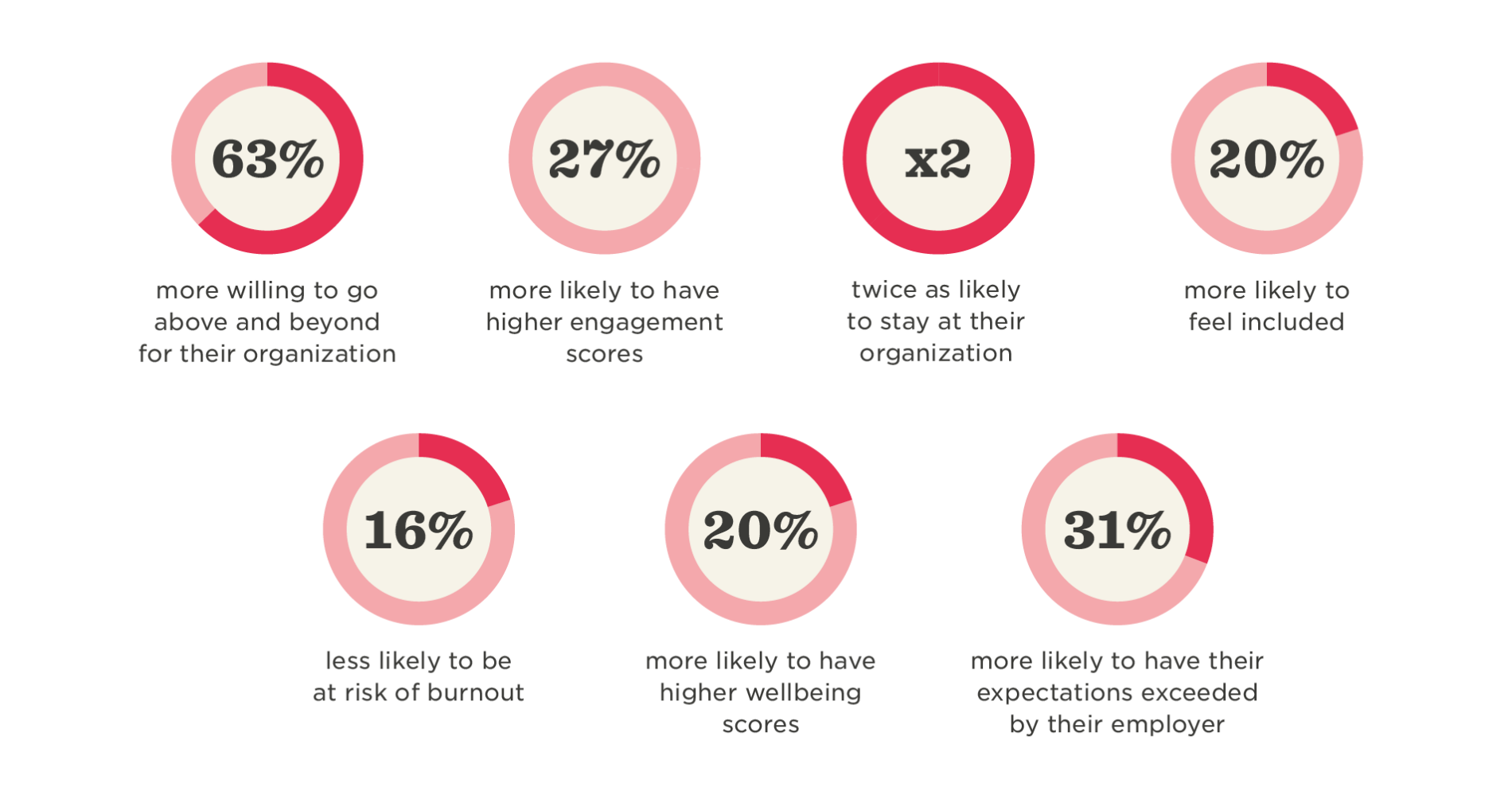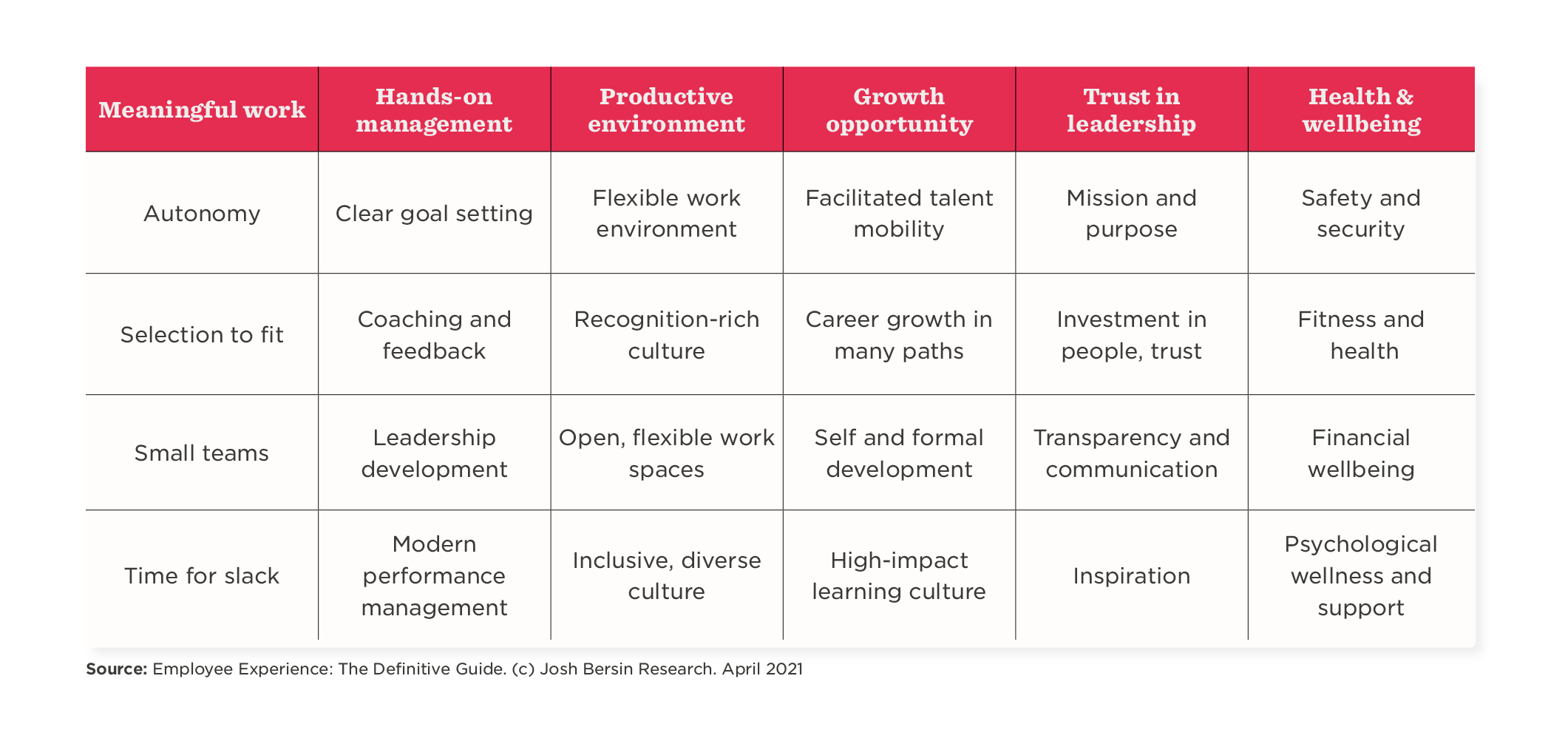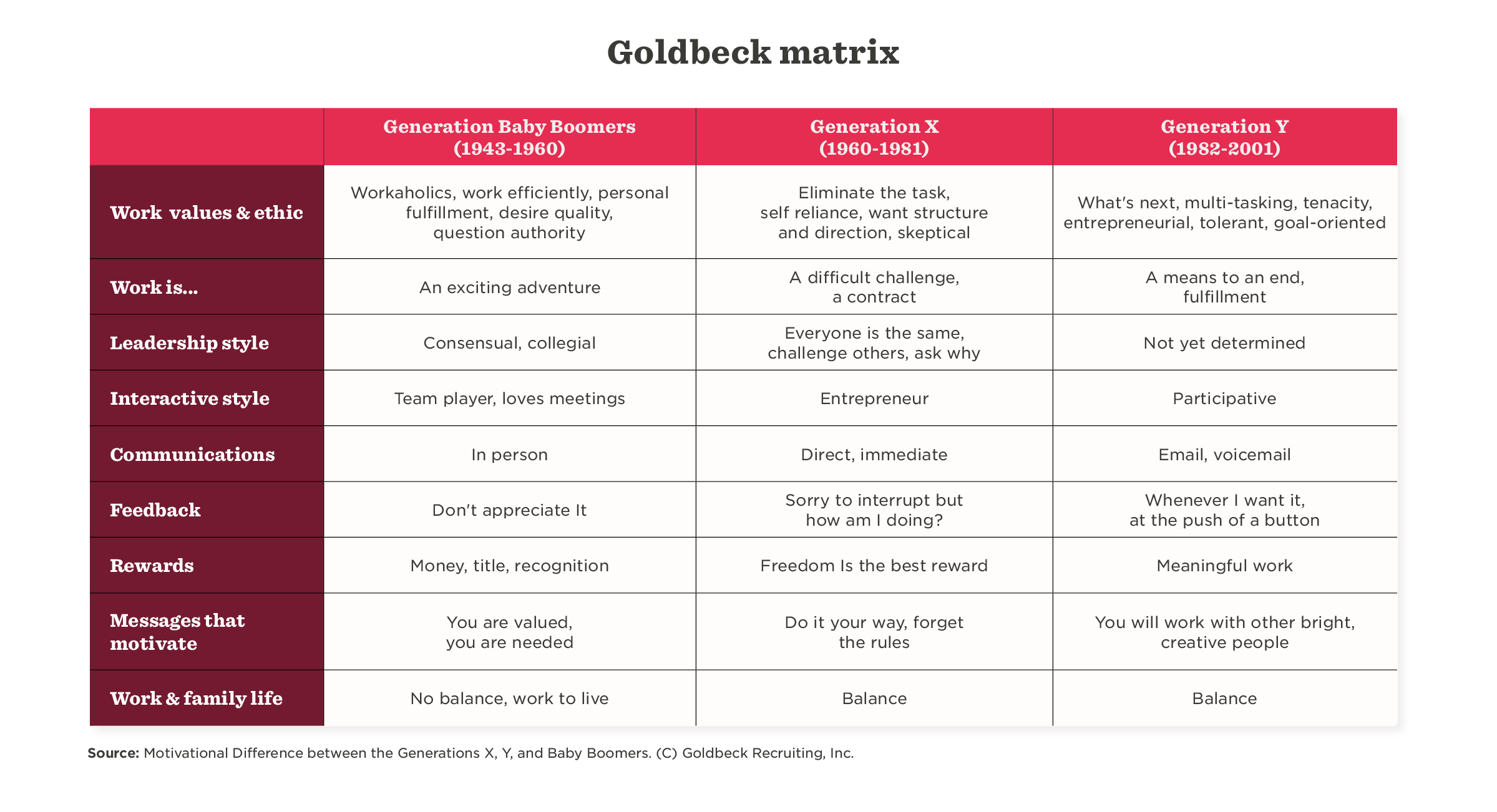Employee experience is one of the most important factors to consider as an HR leader.
That might not be news to you, but along with employee engagement, the experience your people have at work still plays a key role in vital metrics such as retention, employee satisfaction, and team morale.
Gallup offers two definitions that help differentiate these key HR terms:
“Employee experience constitutes the entire journey an employee takes with your organization. This includes everything from pre-hire to post-exit interactions and everything in between.”
Employee engagement occurs when team members “are involved in, enthusiastic about, and committed to their work and workplace.”
In many ways, you can’t have one without the other, nor can you leave either behind if you want to deliver against your company’s overall strategy for success.
“CEOs and business leaders are heavily focused on productivity improvements, organizational transformation, and the development of new digital business models. Success in these areas is not possible if employees are having a hard time getting their work done,” according to Josh Bersin.
Data from the Qualtrics 2023 Employee Experience Trends Report details how effective employee experience strategies critically impact successful business strategies. It states that working professionals who have a positive experience are:
- 63 percent more willing to go above and beyond for their organization
- 27 percent more likely to have higher engagement scores
- Twice as likely to stay at their organization
- 20 percent more likely to feel included
- 16 percent less likely to be at risk of burnout
- 20 percent more likely to have higher wellbeing scores
- 31 percent more likely to have their expectations exceeded by their employer

Employee experience includes every event across a team member’s entire tenure with your organization. Think of it as all the moments between “hire to retire.” Experience builds upon every job, task, conversation, project, interaction, failure, and success your people face while they are members of your organization.
Josh Bersin illustrates the complete employee experience using six key pillars.

But here’s where it gets tricky. The employee experience isn’t just dictated by what’s happening inside your organization but also by what’s happening outside of it.
The aftermath of COVID-19, geopolitical conflicts spilling over into the workplace, rising inflation, and uncertain economic outlooks have all played a huge role in people’s morale, engagement, and health. How organizations address these external factors directly impacts the employee experience.
Considering every possible touchpoint with team members, keeping track of and measuring the outcomes of “complete employee experience” can feel like a massive challenge. To help relieve the pressure, this guide offers strategic approaches and walks you through steps you can take to begin evaluating the employee experience in your organization.
Where should you start with employee experience?
The best company cultures put their people first. After all, your people are what make your organization tick. That’s why the best company cultures put as much care, consideration, and thought into their people as their customers.

Great employee experience management uses design thinking to empathize with people. Design thinking can help you understand how your people experience each situation better and design solutions to resolve any issues you uncover.
Define your employee lifecycle stages
Start by defining the employee lifecycle, or employment stages, within your organization. Each stage typically has an overall purpose to which it’s aligned. A standard lifecycle includes onboarding, developing, retaining, and separating.
Onboard. Effective onboarding strategies can help give new starters the confidence that joining your team was the right decision. Provide them with the welcome, orientation, mentoring, and company experiences needed to get the best possible start in your organization.
Develop. A positive learning and development experience can motivate productivity and inspire staff to deliver in line with your company strategy. This stage also includes promotions and pay increases associated with changes in job levels and roles. Offer opportunities for mentoring, performance management, coaching, and professional growth.
Retain. Establish great relationships with your top talent and build trust. Fostering a culture that champions autonomy and schedule flexibility can be a fantastic way to show that you respect and value your people’s needs. This stage is critical to ensuring your people have experiences that encourage them to stay with your organization as long as possible and feel valued and empowered in their work-life balance.
Separate. Understand and assess the reasons why people leave. As part of separating, conduct exit interviews to ask questions about their experience. These interviews are crucial for getting honest feedback and understanding both the highs and lows of their tenure. You can use these valuable insights to improve organizational practices and retention strategies.
Once you have a map of the employee lifecycle, identify the ideal touchpoints at each stage. For example, in the case of onboarding, you might have touchpoints such as:
- An engaging welcome letter from the organization
- An encouraging manager phone call or message before the first day
- Instructions about what the first day will include and where they need to be
- The first-day experience (orientation, team introductions, equipment)
- Setting job expectations for the first 30, 60, and 90 days
- Consistent one-on-one meetings scheduled with their manager
- Schedule meetings with key colleagues and collaborators
Employee lifecycle stages are just the beginning of understanding all the experiences that truly make a lasting impact. The next essential step is understanding your team members.

Identify your workforce personas
As you begin to consider the employee experience, take a look at your team. Who are they? What information do you have regarding each person in your organization? If that sounds too basic, it’s not. People are 21 percent less likely to job hunt when they feel as if they are known and understood by their organization.
On the most basic level, to effectively manage the employee experience, organizations require an HRIS/HCM that collects and provides access to the information and insights you need.
When the data is available, it’s far easier to identify your employee personas. Employee personas represent different groups of team members, so you can create profiles that describe their needs, values, and behaviors. This step is essential to truly understanding your people and clarifying who needs what for a unique and optimal workplace experience.
“When it comes to employee experience design, you must be strategic in setting your priorities. Trying to do too much at once is inviting failure. Every job role is different. The experiences of sales representatives are very different from those of customer service representatives,” according to Bersin.
For example, in search of creating more productivity and satisfaction for team members at work, Cisco identified five key personas to address workplace design:
- Highly mobile. Salespeople, account managers, systems engineers.
- Campus mobile. Business development managers, executives, manufacturing, and logistics.
- Remote/distance collaborator. Analysts, customer service and support, HR, legal, marketing, training, and program and product managers.
- Neighborhood collaborator. Engineers, finance staff, many managers.
- Workstation anchored. Administrative staff, software, and network engineers.
Then, after reviewing how each persona worked, Cisco “designed a variety of types of spaces for concentrating, collaborating, learning, and socializing.”
Similarly, once you’ve identified the personas you’re working with, you can match perspectives for each persona to various points within your standard employee lifecycle. What are the critical touchpoints, needs, and expectations for each persona in your workforce at each stage?
For example, in onboarding, you might have identified that a sincere welcome on the first day is essential, as is setting job expectations for the first 30-60-90 days. With that touchpoint in mind, you can identify what works best for each persona.
Using the Cisco personas, persona-based onboarding might take the following approach:
- Highly mobile. These team members receive a virtual card or video from their manager.
- Campus mobile. Managers schedule a time and place to meet with the new joiners on campus.
- Remote/distance collaborator. Managers set up a web meeting with the team to make introductions and host a welcome celebration.
- Neighborhood collaborator. An intranet message welcomes this new team member and invites others to stop by and say hello.
- Workstation anchored. A sign welcomes the new team member at their workstation.
There are many other touchpoints in onboarding, but this idea of how to welcome people based on their persona provides a perspective of how you can personalize each experience.
As you go through the lifecycle and apply the needs of each employee persona, take note of existing elements that provide peak experiences, as well as moments that may seem like valleys. These peaks and valleys will help you identify things you’re doing well alongside new experiences to implement.

Acknowledge and commit to what’s important
Even with a strong focus on the employee experience, the research shows there’s room for improvement. According to the Achievers Workforce Institute, 61 percent of people still have one foot out the door.
Culture, recognition, and communication all offer ways to acknowledge and commit to what’s essential for your team members—these can all improve daily work experiences.
Culture
There’s a significant advantage to embracing a culture of open communication and feedback. In fact, people who say their companies take meaningful action on their feedback were 37 percent less likely to job hunt in 2023.
Fostering an organizational culture where everyone’s voice is heard gives you the chance to improve the day-to-day working lives of your people, which in turn can boost both engagement and commitment—and improve employee experience.
Additionally, prioritizing a healthy, safe, people-centric culture with a strong commitment to DEI&B ensures respect and fairness across gender, age, and culture—all of which help to enrich your organization’s environment.
Recognition
Recognition is a great way to engage your team. But problems arise when organizations view recognition as a stand-alone initiative, rather than a crucial piece of their culture.
To ensure recognition supports and boosts the employee experience, integrate appreciation into every element of your team’s work. Don’t save recognition just for the big moments like tenure anniversaries or project milestones. Reward and recognize people in the moment, too.
By appreciating your team’s efforts as often as possible, you’re more likely to reap a wide range of impressive benefits—with research from the Achievers Workforce Institute showing that recognition is the number-one driver of connection, and people are 57 percent less likely to job hunt when they’re given regular recognition.
Pay transparency
Embracing pay transparency is a vital step in building trust and fairness within your organization, but it’s a tricky task to get right.
92 percent of today’s professionals say they support pay transparency laws, but according to a survey by Willis Towers Watson (WTW), 31 percent of organizations say they just aren’t ready for transparency.
The Employee Experience Trends report states that 61 percent of people believe they’re paid fairly for the work they do, so by demystifying compensation decisions with your team, transparent pay practices address pay concerns while reinforcing your organization’s commitment to fair and unbiased pay practices.

Communication
If you want to improve the employee experience, it’s important to embrace open, two-way communication.
This isn’t just a case of leaders and managers being open and transparent, but actively encouraging feedback from team members. Whether it’s through regular team and one-on-one meetings, town hall gatherings, or online feedback platforms, make sure to listen to and value what your people are telling you.
Frequent, open feedback promotes engagement, transparency, and trust—all vital for empowering managers and individual contributors. To boost communication, consider holding training sessions in empathetic communication, particularly for multi-generational, diverse, and multi-cultural teams.
Finally, in these modern global work environments, effective communication across dispersed teams is key. With a robust, global communications infrastructure supported by a people-focused tech stack, organizations can keep teams connected and aligned, and foster a community feel in a dispersed and productive environment.
Adapt the employee experience as your business evolves
Just as your business grows, so does the experience of your people. Leadership changes, turnover, and new initiatives can all impact the day-to-day experience in your organization.
As competing priorities fill your day, it’s easy to lose sight of the employee experience until it’s too late. Rather than overhauling your employee experience every year, put some tools in place to track and assess how things are going on a regular basis.

Conduct performance reviews
Great HR leaders understand the value of listening—with 37 percent of them prioritizing listening and taking action on feedback from 2023 to engage and retain talent.
Be proactive: Make regular performance reviews a priority at your organization. Whether they take the form of quarterly check-ins, annual performance discussions, or weekly one-on-one meetings between managers and team members, it’s important to make listening and getting feedback from your people a frequent practice.
It’s essential to use the time you take to connect wisely. Almost every conversation with your team members gives you the chance to ask how they feel about work and to listen for any peaks and valleys in their experience.
Benchmark other organizations
If you’re facing employee experience issues in your organization, your peers in other companies will likely understand. Taking time to benchmark peer organizations provides valuable insights about what might work for your organization, too.
Gartner offers these initiatives regarding what the best companies are prioritizing as they look ahead to 2024:
- Leader and manager development
- Organizational culture
- HR technology
- Change management
- Career management and internal mobility
Consider if any of these initiatives from the best companies are ones you might be able to focus on. Reach out to colleagues in your area and industry to inquire about their challenges, offer advice, and ask for their strategic employee experience suggestions.

Recommended For Further Reading
Be aware of generational needs
When it comes to learning how to motivate your people, each generation experiences workplace motivation differently. Goldbeck’s Generational Values and Personality (2010) matrix outlines stereotypical values and personalities ascribed to different generations regarding work, motivation, leadership, and others.
Recent trends also highlight the importance of understanding the wide range of generational needs. For example, Gen Z professionals tend to seek jobs where they feel empowered to make a difference in social or environmental issues.
On top of this, the Great Unretirement emphasizes the need for reskilling, embracing technology for older team members, and encouraging knowledge-sharing and mentorship opportunities.
So when you review and examine the employee experience and what motivates your workforce, be sure to keep the various needs of each generation in mind.

Realize the full potential of employee experience
Of course, your team members aren’t customers or consumers, but it’s wise to treat their experience with the same level of care and concern. Just as a great meal makes a satisfied customer return to a restaurant, treating people with respect, listening to them, providing growth opportunities, and appreciating their contributions can drive them to stick with your organization.
Companies can reap the benefits of delivering a positive employee experience with engaged team members, increased revenue, innovation, and greater levels of employee satisfaction. For the employee experience to positively impact your business strategy, it’s important to listen to your people and act on their valuable insight.
Crafting the optimal employee experience may not be simple, but it’s one of the most critical undertakings an organization can take on—and one that drives exceptional results.
